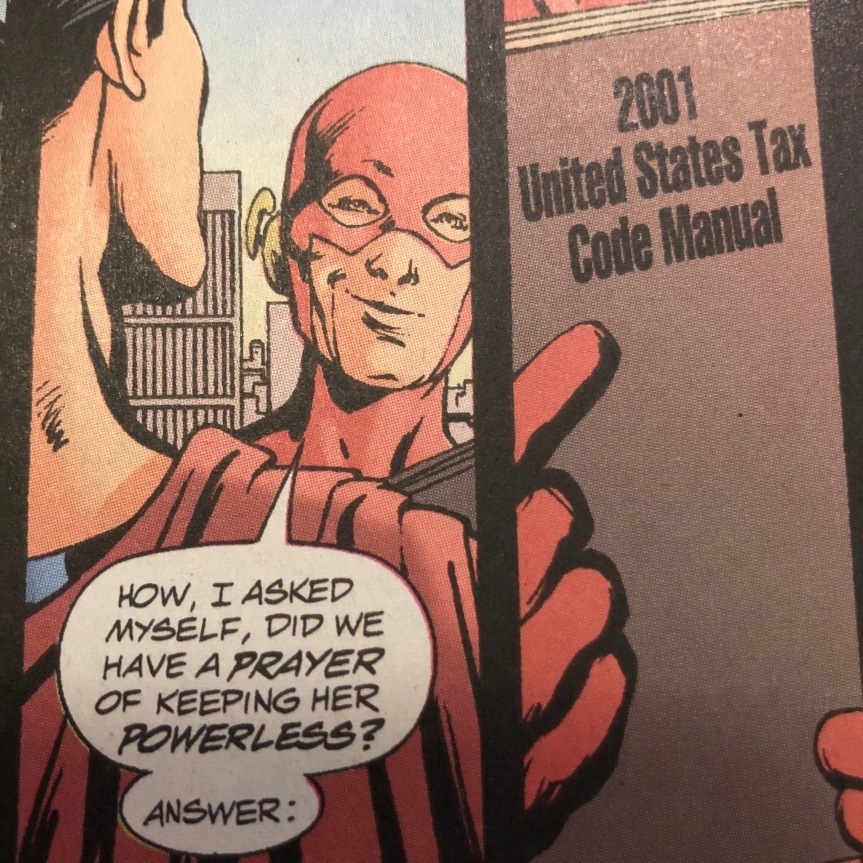By: Leandra Lederman
Recently, my resident D.C. comics fan, Nickolas Cole, asked me to watch with him Episode 3 of the animated Harley Quinn TV series, “So, You Need A Crew?”. (Warning: this show is not safe for work.) He thought I would enjoy the premise of the episode, which is that female supervillains face a glass ceiling. (You can’t make this stuff up. Well, actually, I suppose you can and someone did!)
I’m not much of a fan of cartoons but I thought the quirky humor was pretty well done. So, there I am watching Harley Quinn struggle to recruit a crew to work for her when all of a sudden, there’s the U.S. Master Tax Guide! And it has the voice of Wanda Sykes. The writers didn’t miss a trick. The intro to the tax stuff features the tax-preparation boutique “TAXES 4 FREE* *NOT 4 FREE,” seemingly ripped from the headlines. (That appears at 1:17 here, but if you don’t mind cursing cartoon characters, you may enjoy the whole three-minute segment, which captures a lot of the premise of the episode.)
Harley Quinn hears the tax preparer but it takes a moment for Harley to locate her because the preparer turns out to be a smoking (literally) copy of the U.S. Master Tax Guide. The supervillain the Queen of Fables is trapped inside. She explains that the heroes (the Justice League) punished her “in a way no one has ever been punished” by imprisoning her inside the book.

With a little research, I soon learned that the Queen of Fables is a character from the comics. As the animated TV series shows, she brings to life storybook characters to use for her own ends. The reason the Justice League trapped her in the U.S. Master Tax Guide (often erroneously referred to in summaries online—an even in Episode 7 of the TV series—as the U.S. Tax Code) is that they thought “she could find nothing imaginative to use as a weapon” there. That part comes straight from the original source of the story, a 2001 JLA comic (though it uses yet a different name for the tax book):

But the Justice league was wrong when it thought tax law was boring and bland! In the comics, it turns out there was plenty in the tax book for the Queen of Fables to use to her advantage and thereby escape: “No one is more adept at spinning romantic fantasia then a man with debt and no way to pay it” (Action Comics No. 834, Feb. 2006).

By contrast, in the TV series (Episode 7, “The Line”), the Queen of Fables was released from the tax book because “a judge found her imprisonment in a U.S. Tax Code to be cruel and unusual punishment!”
I have no idea why this story about a storyteller turned out to involve the U.S. Master Tax Guide. That CCH book is pretty specific, even if it is later treated as interchangeable with the Internal Revenue Code. (Imprisoning someone in the U.S. Master Tax Guide make so much more sense. I mean, the Code has more than one volume!) Maybe one of the writers or their significant others has experience as a tax professional? In any case, tax professionals will likely appreciate the allusions to the plight of the beleaguered tax preparer. In Episode 7, the Queen of Fables complains to Harley, “I’ve got a two o’clock with an independent contractor who keeps his receipts in a f**kin’ ALF lunchbox.”
Wikipedia credits Gail Simone, Mark Waid, and Bryan Hitch as having created the Queen of Fables. Gail Simone, who is credited as writer in Action Comics No. 834 (the one where the Queen escapes), has a pretty interesting story herself!


If you enjoyed this post, you may also enjoy my post on “Superman, Tax Evader?”, https://surlysubgroup.com/2020/12/27/superman-tax-evader/, and “Taxman At 50”, https://surlysubgroup.com/2016/08/05/taxman-at-50-draft-planned-for-aug-5/.
LikeLike